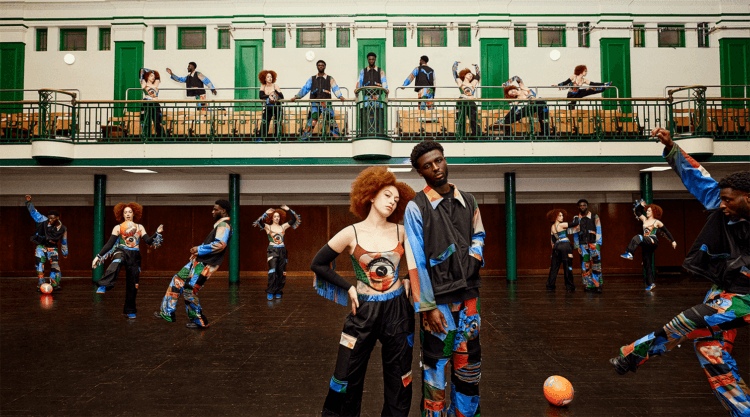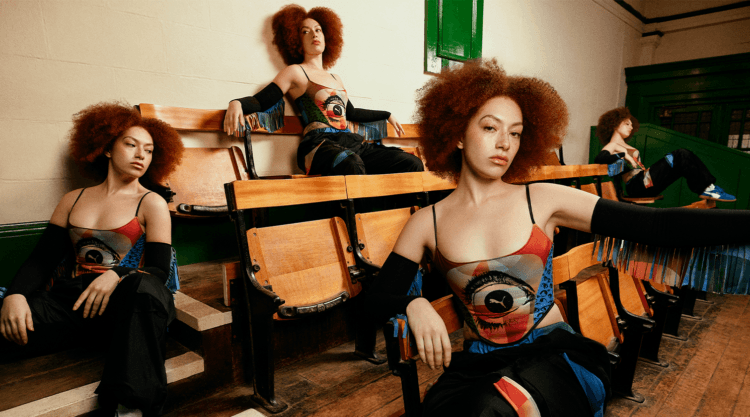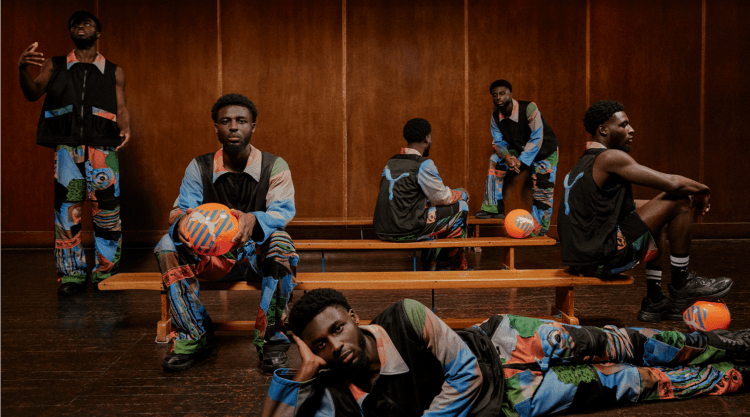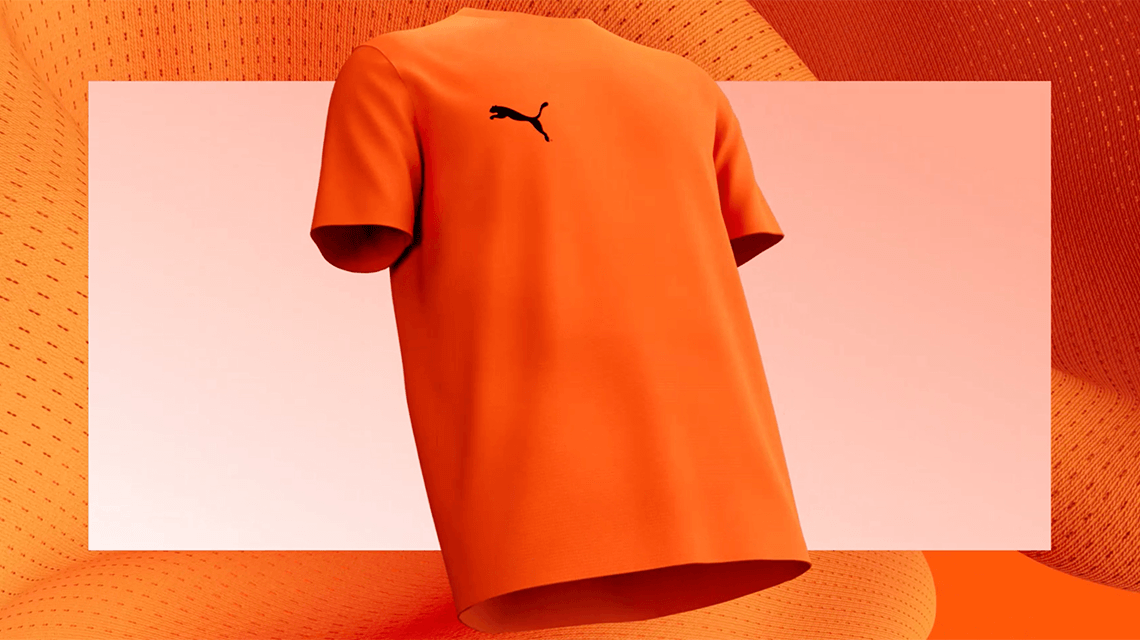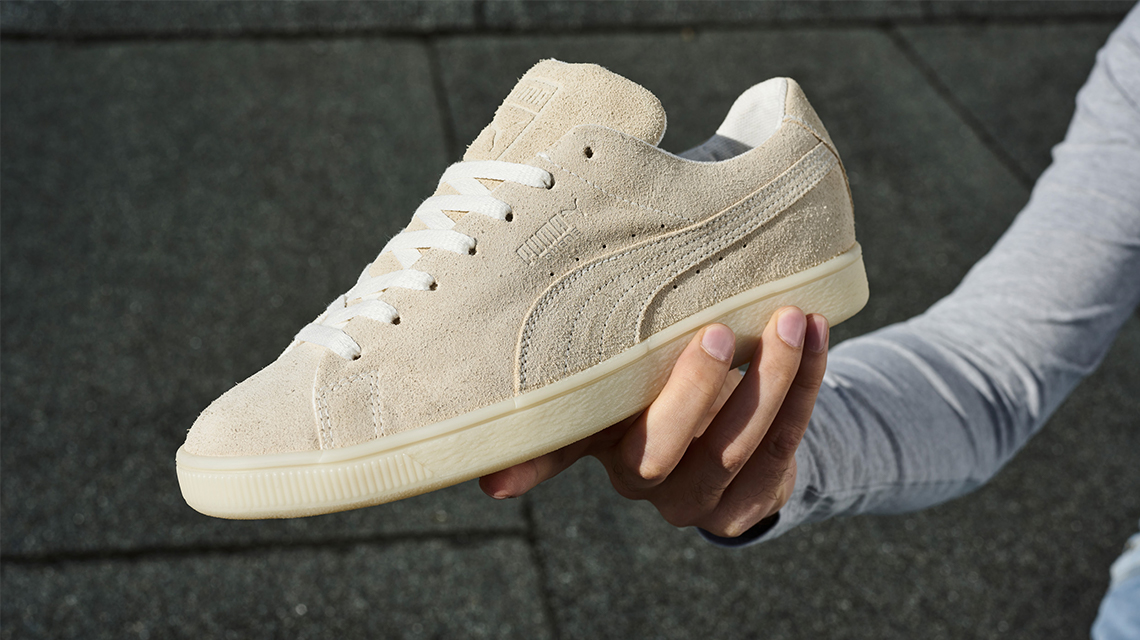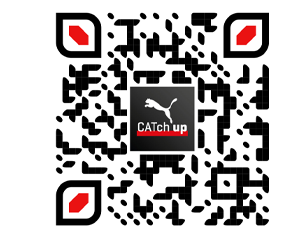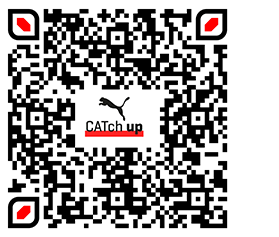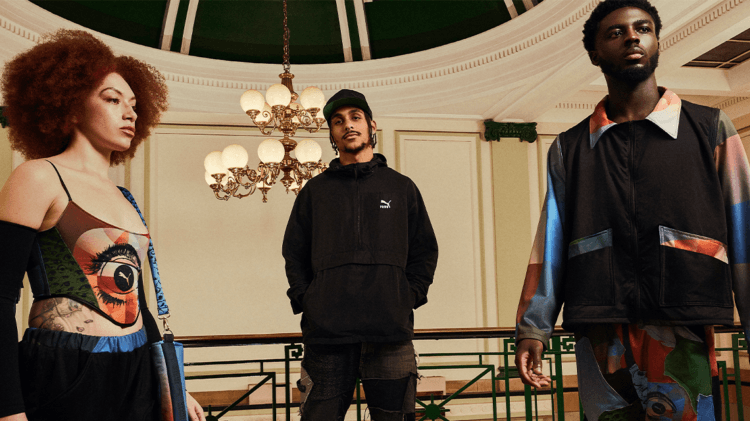
Interview with Andrew Burgess
"It's more than meets the eye— producing sustainable fashion isn't just about assembling pieces, there’s an entire journey."
December 11, 2023"It's more than meets the eye— producing sustainable fashion isn't just about assembling pieces, there’s an entire journey."
December 11, 2023Andrew Burgess, one of our Voices of a Re:Generation, is not only dedicated to upcycling materials into trendsetting new outfits, he is also an advocate for sustainable fashion and inspires a new generation with his colourful designs. On his journey to transform the way people consume fashion, he has created five designs, each crafted entirely from our recycled polyester RE:FIBRE fabric.
We had the pleasure to sit down and chat with Andrew about his collaboration with PUMA, his inspiration for the collection and his own brand, Vivid Vision at the photoshoot in London.
So how did you discover your passion and talent for upcycling and design?
Andrew: I developed a passion for clothing, particularly thrifting, around the age of 14 or 15 because it was cheap and I didn’t have much money for new clothes. Thrifting was both affordable and a super fun hobby for me and my friends. By then, there was so much cool stuff in thrift shops and I followed designers like Nicole McLaughlin on social media, so, the idea of upcycling became intriguing. For my 17th birthday, I received a sewing machine and decided to experiment with creating my own pieces. Since I was already into thrifting, upcycling seemed like a natural step and it’s easier to get into, because you don’t need to fully construct garments. You can just take jeans, open them up and like put patches on them and sew them together.
How did you get into sewing?
Adrew: I got into sewing through social media, following accounts like Imran Potato who really inspired me. What caught my eye initially were their bootleg designer pieces—baby dolls with Gucci prints and pants with unique strips. So, I was like, that’s really cool I want to try it out myself. I played around with it a bit, but it wasn’t until I was 19 that I started upcycling consistently.
What does a typical day look like for you?
Andrew: I usually wake up around eight, check emails – many from you guys these days 😉 and tidy up my workspace before hitting the gym. In the last seven months, I’ve been on a health kick with my girlfriend Paige. A big part of my career is content so when I get back I dive into content creation and editing videos. If I don’t have any specific projects to work on, I sew quilt hoodies for my brand VIVID VISIONS. These are my main product so I can whip those up really fast just because I’ve made probably thousands at this point. I’m constantly brainstorming and plotting my brand’s next move and working on building a strong brand identity. It’s not just about making unique upcycled pieces; I want to develop a cohesive brand story and scaling it up is my current focus.
And how does your involvement in Puma’s Voice of a Re:Generation initiative fit with your personal journey and values so far?
Andrew: Sustainability is at the core of my personal brand. Throughout my career in video content creation, I’ve collaborated with various brands on sustainability projects, from Levi’s and Dickies to unexpected, non-fashion related ones like Sprite and Honda. The Voices of a RE:GENERATION project with PUMA to me is a unique long-term opportunity that gives me insights into sustainability at a global, corporate level in the fashion industry. Despite being on a microscopic scale compared to PUMA, it’s an eye-opener about aspects of sustainability I hadn’t considered as a brand owner yet.
You recently visited factories in Turkey where they produce our RE:FIBRE products. What did you learn about PUMA’s RE:FIBRE program there?
Andrew: It really opened my eyes to the massive amount of research and technology involved in RE:FIBRE and sustainable fashion. It’s not just about sewing clothes; there are full-blown laboratories working on everything from creating fibres to breaking down and removing colors through chemical processes. It’s more than meets the eye— producing sustainable fashion isn’t just about assembling pieces, there’s an entire journey.
What was the most memorable part of your visit to the RE:FIBRE factories? Can you share a moment that significantly influenced your views on sustainability or altered your perspective?
Andrew: One standout moment during the project was seeing the fabric come to life — watching my designs being printed and sublimated was a really proud moment and memorable experience. Seeing the fabric being knitted together with 50 strings fed into machines that created a deafening noise even with earplugs was also pretty crazy. What kind of altered my perspective or something we often forget when talking about sustainability is that it’s not only about sustainable products but also about the people who work at the factories. On site, we discussed working conditions and wages and first I was surprised at the wage levels, but one guy talked about how much his lifestyle improved due to sustainability measures in place. That’s something that really stuck with me.
As part of our Voices of a RE:GENERATION and with everything you know now of the RE:FIBRE process, what would be your advice for PUMA to make sure that the younger Generation “get’s it”?
Andrew: I think PUMA is on the right track with initiatives like The Voices of a RE:GENERATION. Social media is crucial for reaching the youth, but attention spans are very short. So, understanding the need to make sustainability cool and engaging, and avoiding dull and drawn-out content is the way to go. I’m obviously biased but I think a great example of this is the Re:HACKS series I worked on with PUMA. Social content series like that or the PUMA RE:GEN reports podcast make a huge amount of information way more digestible. It’s still a challenge to get people to care about sustainability but I think we’re on the right path.
How can you see influencers like yourself contribute to fostering more transparency in the fashion industry?
Andrew: It’s difficult because in the fashion world, there are influencers on both sides—those advocating sustainability and others promoting fast fashion. While the industry generally is shifting more towards sustainability, global powerhouses like Shein are still prominent. The challenge lies in how influencers, like myself, contribute to transparency in fashion. As a sustainable influencer, I believe in collaborating with brands that are genuinely committed to sustainability and avoiding partnerships solely for monetary reasons helps to sway the overall narrative on social media. It’s a tricky question, but I would say just generally there’s a need to shed more light on what is being done right in the fashion industry by global players.
Tell us more about the creative process behind your Closed Loop Collection and how your visit to the factories influenced this?
Andrew: I wanted to embody the RE:FIBRE process in my designs, with the scrappy patchwork style on the pants symbolizing offcuts and defective garments. The shorts are inspired by baggy vintage basketball warm-ups’ silhouette to lean into PUMAs sporting roots. I was originally planning rip-off pants, but opted for a zipper transformation to reflect the RE:FIBRE process that transforms old into new. The elements of the patchwork and the layered strips of fabric mimic the yarn being woven together and tying back to the sustainability aspect. My brand leans into red, green, blue color palette and the ability these colours offer to make new shades. We incorporated the orange colour to align with PUMA’s Thread the Loop campaign and we also incorporated the iconic eye image, referencing on Linford Christie’s PUMA contact lenses and the FOREVER.BETTER. logo.
So you used recycled fabric as well as offcuts from your thrifted clothes to design your pieces. What were the challenges of using offcuts and the RE:FIBRE fabrics in your designs?
Andrew: I don’t usually work with polyester, so working with thin, stretchy material was a departure from my usual heavy, non-stretch fabrics like denim and quilts. I had some initial challenges — tweaking machine settings, adjusting thread tension, stuff like that but after a few trial runs and crafting a test pair of shorts, I got the hang of it. Adapting to a different material that I’m not really used to was the most challenging part of this project for me.
Which is your favorite technique to use for your upcycling products?
Andrew: Patchwork really holds a special place for me, it goes back to my roots when I first started. There’s just so much to patchwork, it offers various styles from distressed rough cuts, like the ones here, to clean finished patchwork. It’s a dynamic and meaningful element in my work and it aligns with my brand because there’s endless creativity with patchwork, whether it’s heart patches like the ones on my girlfriend’s pants or other unique designs.
So can you tell us more about your brand Vivid Visions. How, when and why did it come about?
Andrew: I started in 2017 with “Threat of Joy,” a streetwear brand, but it lacked consistency and went a bit on the back burner. In 2019, I fully delved into upcycling, selling designs under the same name. Realizing that the name didn’t align with my vision, I rebranded to Vivid Visions in 2021, initially with no defined brand identity. Last year, the brand gained traction on Instagram, reaching 100,000 followers. As I’m currently a one-man team for one-of-one pieces, I’m exploring scalability with manufacturers while maintaining sustainability. I’m also working on building a cohesive brand identity, I want to introduce more accessible and cost-efficient pieces alongside handmade one-of-ones. Scaling up is a challenge, but I’m excited about the journey.
What message do you aim to convey through the Vivid Visions X PUMA designs?
Andrew: The main goal was to highlight the RE:FIBRE process. It’s a challenge to pinpoint a specific message, but my brand motto, “Where the Past Meets the Future,” encapsulates it too since the designs incorporate pre-loved, secondhand items and RE:FIBRE fabric. It’s about recognizing the value in old items, whether through personal upcycling or processes like RE:FIBRE. I hope to see similar initiatives for materials like cotton and poly blends in the future.
As a self-taught designer focused on sustainability, how do you balance your personal brand, Vivid Visions, with your collaboration with a global brand like PUMA?
Andrew: Because I love what I do. Balancing my small sustainable brand with a global powerhouse like PUMA can be challenging optics-wise. While my brand focuses on one-of-one pieces, PUMA operates on a massive scale. However, it’s a valuable learning experience as I aim to transition into manufactured pieces sustainably, always keeping one-of-ones. So far, the collaboration’s not widely known on my brand page, so feedback is yet to come. I’m absorbing information and looking for ways to apply it to enhance my brand.
